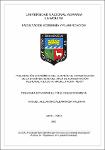Mostrar el registro sencillo del ítem
Valoración económica del servicio de conservación de la biodiversidad del área de conservación regional Vilacota Maure,Tacna - Perú
| dc.contributor.advisor | Alarcón Novoa, Jorge Alfonso | |
| dc.contributor.author | Albarracin Valdivia, Miguel Alejandro | |
| dc.date.accessioned | 2021-05-25T16:28:16Z | |
| dc.date.available | 2021-05-25T16:28:16Z | |
| dc.date.issued | 2020 | |
| dc.identifier.uri | https://hdl.handle.net/20.500.12996/4720 | |
| dc.description | Universidad Nacional Agraria La Molina. Facultad de Economía y Planificación. Departamento Académico de Economía y Planificación | es_PE |
| dc.description.abstract | El objetivo de la investigación fue estimar el valor económico que asigna la población del distrito de Tacna- Perú, a preservar la biodiversidad del Área de Conservación Regional Vilacota Maure (ACR-VM), que brinda el soporte para la disponibilidad del servicio ecosistémico de aprovisionamiento de recursos genéticos autóctonos, destacando el Suri, como un ave endémica en peligro crítico de extinción. El riesgo que amenaza la biodiversidad del ACR-VM, deriva de actividades antropogénicas como la minería, la crianza de camélidos sudamericanos, la introducción de especies foráneas, la caza furtiva y en menor proporción, de los proyectos hidroenergéticos, la creación de asentamientos humanos, la quema de pastizales y la extracción de tola, han menguado la calidad ambiental de los bofedales, uno de sus principales hábitat, y, de continuar así, el impacto negativo sería irreversible. Aplicando el Método de Valoración Contingente (MVC), se encuestó a potenciales retribuyentes del distrito de Tacna, calculando su Disposición a Pagar (DAP) por conservar la biodiversidad del ACR-VM, en S/. 11.94 por hogar, como pago anual por única vez. Se estimó un modelo econométrico logit derivado de una forma funcional de la función indirecta de utilidad que reveló que las variables significativas en el proceso de decisión de pago fueron: Importancia de recursos genéticos, carga familiar, condición laboral actual y generación de ingresos. El fondo potencial de contribución, que representa una efectiva percepción del Valor de No Uso (VNU) por parte de los potenciales retribuyentes del distrito de Tacna, ascendió a S/. 333 484, que es sólo 31.4 por ciento del fondo de comparación de fuente gubernamental. La no generación de ingresos y la no prioridad de la contribución ambiental, destacan como razones de dicha cuantificación, evidenciando las limitaciones existentes en el actual contexto de pandemia a nivel mundial | es_PE |
| dc.description.abstract | The objective of the research was to estimate the economic value assigned by the population of the district of Tacna-Peru, to preserve the biodiversity of the Vilacota Maure Regional Conservation Area (ACR-VM), which provides support for the availability of the supply ecosystem service of autochthonous genetic resources, highlighting the Suri, as an endemic bird in critical danger of extinction. The risk that threatens the biodiversity of the ACR-VM,derives from anthropogenic activities such as mining, the breeding of South American camelids, the introduction of foreign species, poaching and, to a lesser extent, from hydroenergy projects, the creation of human settlements, the burning of grasslands and the extraction of tola, have diminished the environmental quality of the wetlands, one of their main habitats, and, if this continues, the negative impact would be irreversible. Applying the Contingent Valuation Method (CVM), potential retributors from the district of Tacna were surveyed, calculating their Willingness to Pay (DAP) for conserving the biodiversity of the ACR-VM, at S /. 11.94 per household, as a one-time annual payment. A logit econometric model derived from a functional form of the indirect utility function was estimated, which revealed that the significant variables in the payment decision process were: Importance of genetic resources, family burden, current employment status, and income generation. The potential contribution fund, which represents an effective perception of the Non-Use Value (UNV) by potential payers of the district of Tacna, amounted to S /. 333,484, which is only 31.4 percent of the government source comparison fund. The non-generation of income and the non-priority of the environmental contribution stand out as reasons for such quantification, evidencing the existing limitations in the current context of a global pandemic. | en_US |
| dc.format | application/pdf | en_US |
| dc.language.iso | spa | es_PE |
| dc.publisher | Universidad Nacional Agraria La Molina | es_PE |
| dc.rights | info:eu-repo/semantics/openAccess | en_US |
| dc.rights.uri | https://creativecommons.org/licenses/by-nc-nd/4.0/ | * |
| dc.subject | Zonas protegidas | es_PE |
| dc.subject | Reservas naturales | es_PE |
| dc.subject | Conservación de los recursos | es_PE |
| dc.subject | Investigación | es_PE |
| dc.subject | Biodiversidad | es_PE |
| dc.subject | Valor económico | es_PE |
| dc.subject | Medio ambiente | es_PE |
| dc.subject | Servicios | es_PE |
| dc.subject | Situación económica | es_PE |
| dc.subject | Entorno socioeconómico | es_PE |
| dc.subject | Evaluación | es_PE |
| dc.subject | Perú | es_PE |
| dc.subject | Áreas naturales protegidas | es_PE |
| dc.title | Valoración económica del servicio de conservación de la biodiversidad del área de conservación regional Vilacota Maure,Tacna - Perú | es_PE |
| dc.type | info:eu-repo/semantics/bachelorThesis | en_US |
| thesis.degree.discipline | Economía | es_PE |
| thesis.degree.grantor | Universidad Nacional Agraria La Molina. Facultad de Economía y Planificación | es_PE |
| thesis.degree.name | Economista | es_PE |
| dc.subject.ocde | https://purl.org/pe-repo/ocde/ford#4.05.00 | es_PE |
| renati.author.dni | 42773677 | es_PE |
| dc.publisher.country | PE | es_PE |
| dc.type.version | info:eu-repo/semantics/publishedVersion | en_US |
| renati.advisor.orcid | https://orcid.org/0000-0002-4191-4154 | es_PE |
| renati.advisor.dni | 10492611 | es_PE |
| renati.type | https://purl.org/pe-repo/renati/type#tesis | es_PE |
| renati.level | https://purl.org/pe-repo/renati/level#tituloProfesional | es_PE |
| renati.discipline | 311016 | es_PE |
| renati.juror | Jiménez Díaz, Luis Alberto | |
| renati.juror | Mercado Curi, Waldemar Fernando | |
| renati.juror | Diez Matallana, Ramón Alberto |
Ficheros en el ítem
Este ítem aparece en la(s) siguiente(s) colección(ones)
-
EPL-EP Tesis [166]



